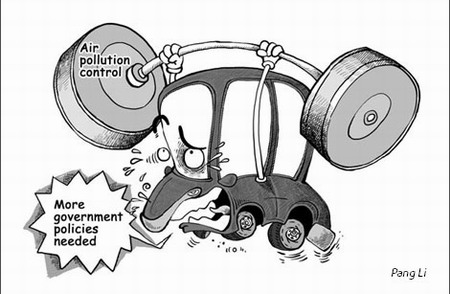
|
BIZCHINA> Review & Analysis
 |
|
Related
Driving home the green car message
By Zhu Qiwen (China Daily)
Updated: 2008-08-30 11:21
 The clear blue skies during the Beijing Olympic Games were impressive not only for foreign visitors. The clean air even led to local people to call for an extension to the two-month odd-even license plate restriction that allows the city's 3.3 million private car owners to drive only on alternate days. After years of efforts to improve air quality, emergency pollution controls like the traffic restriction worked wonders. It brought air cleaner than many people had expected. However, municipal officials should not count on car owners to sacrifice their convenience in order to fix the long-term problem between traffic growth and pollution control. Urban planners in Beijing as well as other cities across China should come up with a holistic solution as soon as possible to strike a balance between the country's inevitable growth of car ownership and environmental protection. Clearly defined policies guiding development of urban traffic are crucial to a consumer's decision on whether to purchase a car or not. For instance, if Beijing adopts an indefinite extension to the odd-even license plate restriction, it will hardly reduce the number of cars on the road in the long run. The reason the emergency measure worked was because most car owners felt a two-month period was bearable. However, if it is extended indefinitely, many of them will consider buying a second car to ensure they can drive every day.
The purchase of a second car will not only thwart urban planners' effort to reduce traffic but also lead to a waste of resources. Private car ownership has been increasing in Chinese cities. Take Beijing for example. This city is now home to about 17 million people and 3.3 million cars. The figure for the latter is growing by 300,000 a year. The country's fast urbanization will see six out of every 10 people living in cities in 20 years. That means the nation will have about 900 million urban dwellers by 2030. It is estimated that the nation has up to 100 million households that can afford a car, but only 20 million have bought one so far. The low penetration rate of cars and the huge potential of the domestic market have understandably made China a magnet for car manufacturers at home and abroad. But the lack of a long-term comprehensive policy on traffic planning will also put off car manufacturers from producing more "green cars". In sharp contrast to sluggish markets in the United States and Japan, China's car sales in the first six month this year increased 18.52 percent year-on-year, indicating strong domestic demand. Though the gradual slowdown of the Chinese economy brought down the growth of car sales last month, it is still believed that sales will rise by double digits this year. For a country that is eager to upgrade its industrial structure, the expansion of the domestic car market that underpins the rapid development of manufacturers is surely welcome. That largely explains why most municipal officials in China have refrained from putting a lid on the growth of car ownership even in the face of mounting public pressure to reduce air pollution and traffic jams. A blanket ban on private car purchase is unthinkable in today's China. The problem is the structure of the country's car sales. At a time when the world is reeling from soaring oil prices and China is struggling to cut energy intensity and pollution, sales of gas guzzlers are still growing much faster than small cars. Statistics show that the country's imports of SUVs in the first half of this year jumped 79 percent to 108,500, accounting for nearly half of the total imports. The growth rate also represents rise of 41.5 percentage points from a year earlier. Under such circumstances, it is no surprise that the Chinese government decided to adjust the consumption tax to curb high-emission cars and promote small ones. From the beginning of next month, the consumption tax on passenger vehicles with big engines will be raised by 10 to 20 percent while that on cars with an engine size of 1 liter or lower will fall from 3 percent to 1 percent. Such a preferential tax policy for energy-efficient automobiles is long overdue. It can cut fuel use and help improve air quality. Nevertheless, this alone will hardly persuade status-conscious consumers to buy efficient car models rather than gas-guzzling sedans. Worse, it has nothing to do with the promotion of "green cars" - those equipped with environmental-friendly technologies. To meet both the people's desire for greater mobility and the country's need to cut pollution and save energy, the government has no choice but to boost production and consumption of green cars. Policymakers should revise industrial policies to urge manufacturers to expand research and development of environmental-friendly cars. Fuel prices as well as consumption policies should also be adjusted to make such cars more attractive to Chinese drivers. Piecemeal efforts are needed to help change the mindset of consumers. But they cannot deliver fast enough the changes as a holistic solution combining environmental protection, urban traffic planning and auto industry development can do. The low penetration rate of cars at present means the price to persuade Chinese consumers to drive in a green way remains relatively low. This is an opportunity policymakers should not miss. (For more biz stories, please visit Industries)
|